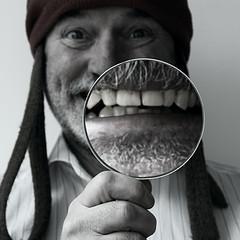
Photo by Martin Sharman.
Everybody dies. If you're lucky, you get to grow old first.However, aging is correlated with an increasing number of bodily complaints. True, people don't all age at the same rate.
This week, I read a The Guardian's summary of a recent study that illustrates this variation.
Basically, almost a thousand people participated in a study that had this bottom line result: At 38 years old, participants of the Dunedin Study Birth Cohort were found to demonstrate chronological "ages" ranging from 28 to 61.
Why did the participants age at different rates?
Genetics, environmental factors, access to affordable healthcare (by benefits, income and proximity), and lifestyle choices affect our aging process. Well, and can never completely outrun Father Time.
[Note: This post's purpose is to raise awareness. This is not medical advice. Please consult with a licensed medical professional in order to better manage your health with preventative care and/or curative care.]
When I read about the physical side of aging, I frequently encounter research about various biomarkers of aging. Because I want to focus on controllable factors, I look through my magnifying glass at biomarkers that can be modified through lifestyle choices.
Depending on our income and social status, we may be able to exert a lot of control over our diet, exercise, tobacco use, alcohol consumption, proper use of prescription medications (and rejection of street drugs), exposure to pollutants, effective stress management (and overall good emotional health), and beneficial social engagement.
The American Federation of Aging Research has a very short guide to the Biomarkers of Aging. They explain that scientists are still trying to pin down what measurable physical attributes can help them predict the aging process. Here is a key quote from their this publication:
"Simply put, biomarkers need to be simple and inexpensive to use. They should cause little or no pain and stress. And they must measure aging accurately."
Ah, "measure aging accurately." That's constantly being debated, and the proliferation of tests and studies will only extend the debate. Because there isn't a set list of biomarkers, it's a bit foolish for me to list them. And these biomarkers can be really technical.
In case you don't believe that it's really easy to get in over your head, here are the 18 biomarkers used in the Dunedin Birth Cohort study summarized by The Guardian introduced at the top of this post. I'm using the labels on Figure 3 of the research publication itself:
- HbA1c
- Cardiorespiratory fitness
- Waist:Hip Ratio
- FEV1/FVC
- FEV1
- Mean arterial pressure
- BMI
- Leukocyte telemore length
- Creatinine clearance
- Urea Nitrogen
- Lipoprotein(a)
- Triglycerides
- Gum Health
- Total cholesterol
- White blood cell count
- hsCRP
- HDL cholesterol
- ApoB100/ApoA1
Before I started my graduate program in gerontology, I could recognize and explain maybe five of these at best. Now I know more about another five. I'd have to research the rest.
Okay, okay. I will start a series of posts on biomarkers of aging, starting with the first of these 18 biomarkers listed above (1 post per month). These 18 biomarkers were employed by Daniel H. Belsky, et al (of Duke University School of Medicine) and published online in June 2015 by the Proceedings of National Academy of Sciences of the United States of America. Abstract.
Before concluding, let me contextualize my interest in biomarkers.
In the years since becoming a gerontologist, I have taken a variety of stances towards aging.
I cycle through these approaches: being stressed out, researching voraciously, obsessing over minutiae of diet and exercise, hanging out with doctor and other medical professionals in an effort to prevent and treat emerging issues, distracting myself with life's pleasures and seeking an emotional-spiritual acceptance.
If I were limited to only one approach to aging, I must concede that I am best served when I take a spiritual approach to accepting the aging process as inevitable but living purposefully with each day that I'm granted life.
Related:
Books on Aging and Spiritual Growth
Leisure World Cohort Turns 90
Walking Rate Correlates with Longevity (See the debate! Walking rate is a biomarker not listed above. It's not as convenient as the biomarkers selected by Belsky et al.)

